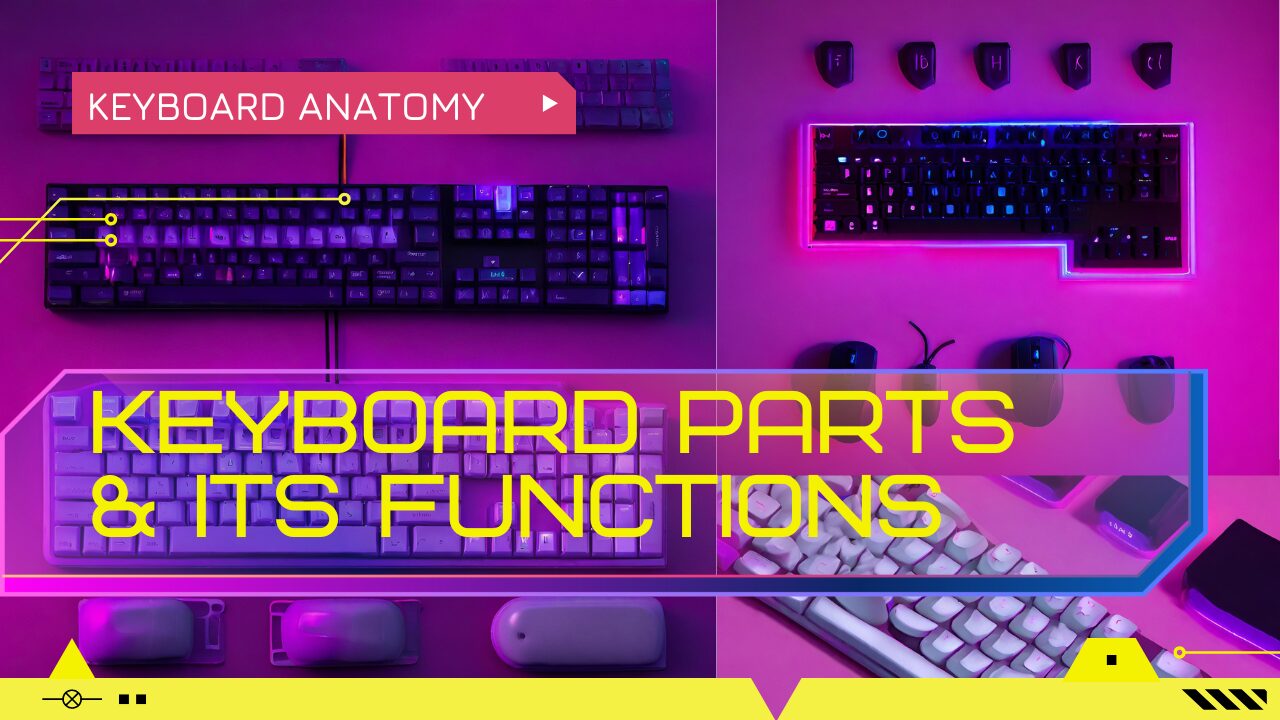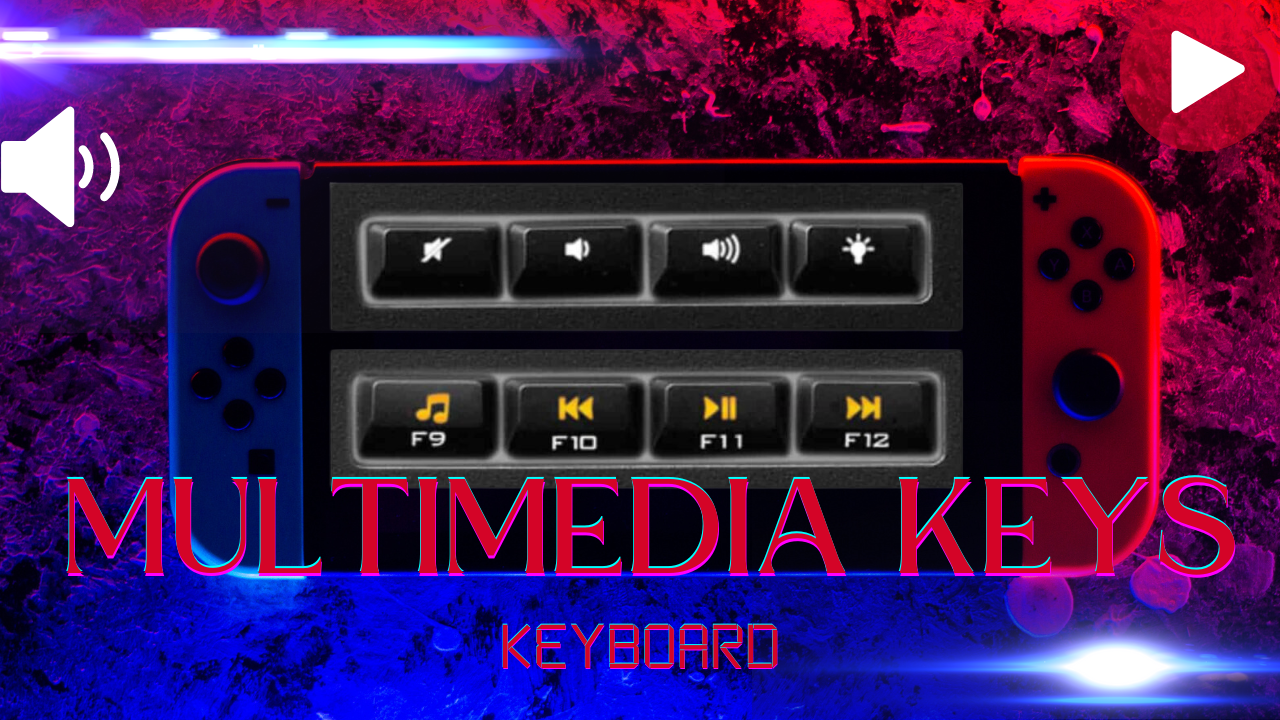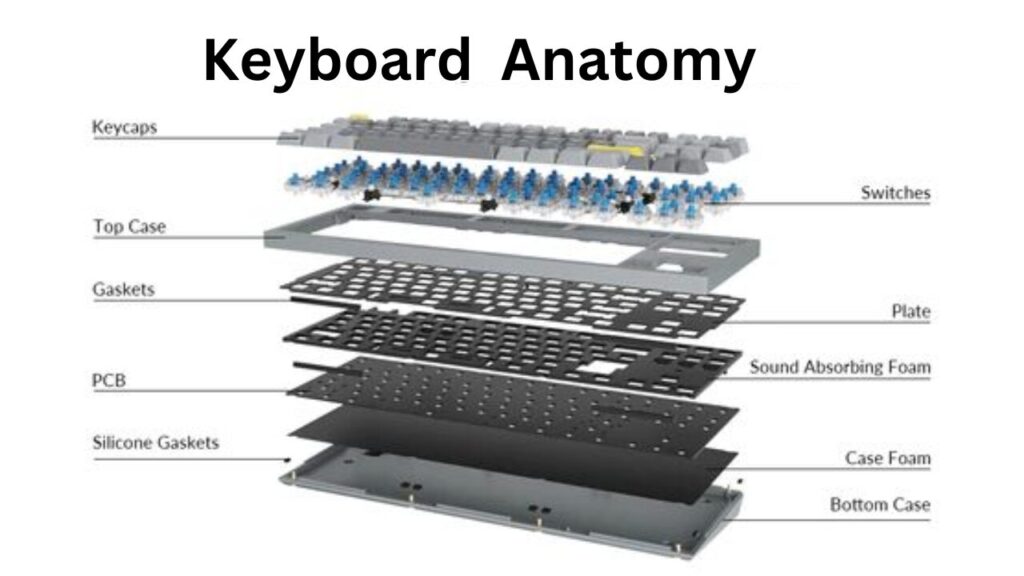
When discussing computer accessories, the keyboard is an essential daily tool. Whether you like playing games, writing, or typing, having an excellent keyboard can improve your experience. But have you ever thought about what’s inside a keyboard?
In this simple guide, we will look at the different parts of the keyboard. Understanding keyboard anatomy becomes easier by learning about its parts.
Parts of a Keyboard: Quick Overview
| Keyboard Part | Function | Examples |
|---|---|---|
| Keys | Produce characters or perform actions when pressed | Letters, numbers, symbols, function keys, modifier keys (Ctrl, Alt, Shift) |
| Keycaps | Covers for keys, labeled with characters or symbols | “A”, “Enter”, “←” |
| Switches | Detect keypresses and send signals to the computer | Mechanical, membrane, low-profile |
| Keybed | Layout of keys, including spacing and arrangement | QWERTY, Dvorak, ergonomic |
| Plate | Stabilizes keys and protects the circuit board | Steel, aluminum, plastic |
| Case | Holds everything together and protects internal components | Plastic, metal, aluminum |
| Keyboard Feet | Offers an optional footbar for tilt and ruler functionality | Elevators, Tilters |
| LED Indicators | Show Caps Lock, Num Lock, Scroll Lock status | Caps Lock LED, Num Lock LED, Scroll Lock LED |
| Cable | Connects the keyboard to the computer | USB, Bluetooth |
| Gaskets | Absorb sound and vibration between components | For stability and flex: “Plate gaskets” or “Gasket mount” |
| Stabilizers | Ensure larger keys (Spacebar, Enter) press evenly | Costar-style stabilizers, Cherry-style stabilizers |
Importance of Understanding Computer Keyboard Anatomy
Before we talk about the names of the different computer keyboard parts, it’s essential to know why they are useful. We can type faster and more accurately by understanding how a keyboard works. We can also fix problems with the keyboard, keep it in good condition, and change it to make it work better for us. Whether you’re a professional writer, computer user, or programmer, understanding keyboards can be extremely beneficial.
Different Types of Keyboards
Before discussing parts of the keyboards, let’s look at the different kinds you can buy. Understanding the differences between keyboard types can help you choose the best one for your needs.
1. Mechanical Keyboards

Specifications:
- Switch Type: Utilizes high-quality switches like Cherry MX, Gateron, or Romer-G for distinct tactile feedback and actuation force.
- Customization: Allows for keycap, backlighting, and key programmability customization.
- Tactile Feedback: Provides satisfying tactile feedback and audible clicks, favored by typists and gamers.
- Anti-Ghosting: Anti-ghosting is a feature that prevents input errors when multiple keys are pressed simultaneously.
Mechanical keyboards are very popular due to their premium durability and tactile feedback. They have special switches under each key that make a satisfying noise or feeling when you press them. Different switches, like Cherry MX, Romer-G, and Kailh, have other characteristics, including actuation force and travel distance. People who play games and type a lot like mechanical keyboards because they are accurate and quick to use.
2. Membrane Keyboards
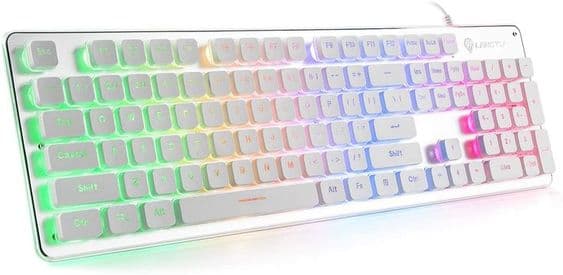
Specifications:
- Tactile feedback: Membrane keyboards provide tactile feedback through rubber or silicone membrane layers, giving users a sense of key activation when pressed.
- Quiet operation: They operate quietly compared to mechanical keyboards, making them suitable for quiet environments such as offices or libraries.
- Slim and lightweight: Membrane keyboards are often small and light, making them convenient for portability and space-saving on desks.
- Dust and spill resistance: The membrane layers protect against dust and liquid spills, enhancing the keyboard’s durability.
- Cost-effective: Budget-conscious consumers often favor Membrane keyboards due to their affordability compared to mechanical keyboards.
Membrane keyboards are the most widely used type in homes and offices. They have a soft rubber or silicone layer under the keys. When you press a key, this layer moves and makes the key work. These keyboards are known for their quiet operation and affordability.
They are often used when noise reduction is essential, such as in libraries or offices. While membrane keyboards may lack the tactile feedback of mechanical keyboards, they are suitable for general typing tasks.
3. Hybrid Keyboards

Specifications:
- Mechanical and Membrane Switches: Hybrid keyboards combine the tactile feel of mechanical switches with the quieter, softer touch of membrane switches, offering a balanced typing experience.
- Customizable RGB Lighting: Hybrid keyboards often feature customizable RGB lighting, allowing for personalization of the appearance.
- Programmable Keys: Hybrid keyboards often feature programmable keys, enabling users to assign custom functions or macros to specific keys for enhanced productivity and convenience.
- Durable Construction: These keyboards typically boast durable construction, often incorporating metal components for increased longevity and stability.
- Wireless Connectivity: Some hybrid keyboards offer wired and wireless connectivity options, providing flexibility for different usage scenarios and preferences.
Did you know about hybrid keyboards? They’re awesome! They combine the best features of both mechanical and membrane keyboards, giving you a superb typing experience. These keyboards employ a combination of mechanical switches and membrane technology, offering a balance between tactile feedback and quiet operation.
Hybrid keyboards are versatile to many users, including gamers requiring precise inputs and professionals prioritizing a calm workspace. The hybrid design allows for customization, making them suitable for various use cases.
Keyboard Key Components and Their Functions
To understand the anatomy of a keyboard, let’s explore the parts and functions of a computer keyboard.
1. Keys

Keys are the primary interface between the user and the computer. Depending on the keyboard layout and user preferences, they come in different shapes and sizes. They are categorized into alphanumeric keys, function keys, and multimedia keys.
Alphanumeric keys include letters, numbers, and symbols, while function keys provide shortcuts for specific actions or commands.
Multimedia keys enable users to control media playback and adjust volume. Keys are typically made of plastic, with options like PBT (polybutylene terephthalate) known for their durability and ABS (acrylonitrile butadiene styrene) being more common.
Different mechanisms underlie the keys, such as scissor switches commonly found in laptop keyboards, rubber dome switches that provide quiet operation, and capacitive switches that are touch-sensitive and widely used in touchscreens.
2. Switches
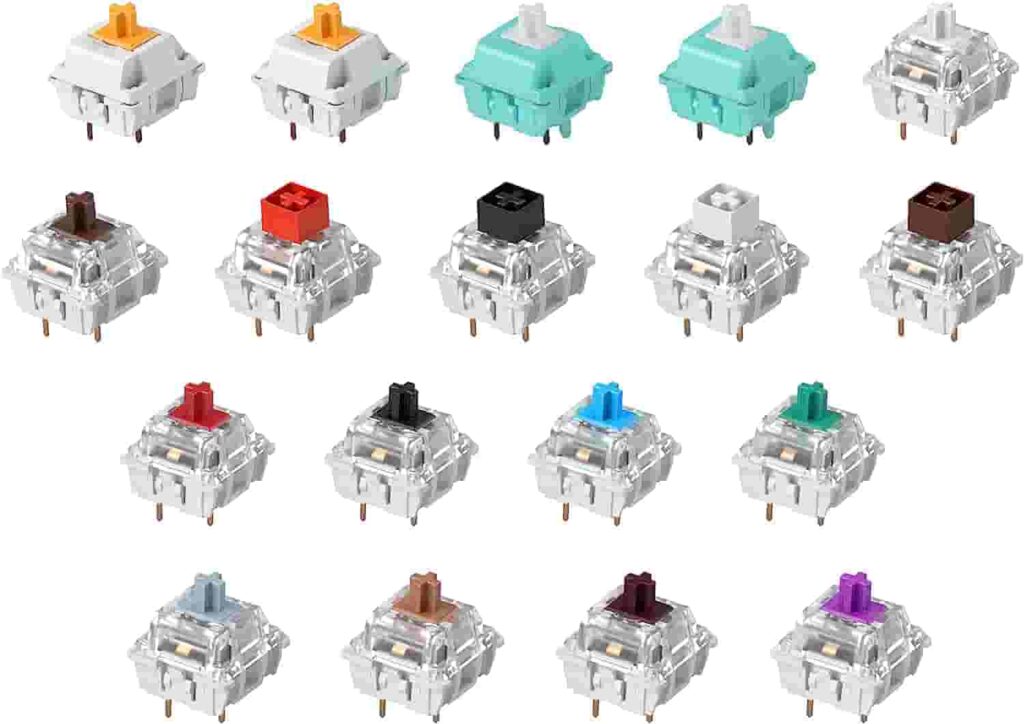
Switches are the mechanical keyboard components beneath each keycap that register keystrokes. Switches vary in characteristics, such as actuation force (the pressure required to register a keystroke), travel distance (the distance the key must travel to register), and tactile feedback (the sensation felt when pressing a key). Choosing the right switch is essential for a good typing experience that suits your preferences. Here are some popular switch brands and their defining features:
Cherry MX:

Cherry MX switches are considered the best and most reliable mechanical keyboard switches in the market. They come in different variants, including Cherry MX Red (linear and lightweight), Cherry MX Blue (tactile and clicky), and Cherry MX Brown (tactile and silent).
Romer-G:

Developed by Logitech, Romer-G switches offer a smooth and responsive typing experience. They are known for their short actuation point, making them ideal for gamers who require quick key presses.
Gateron:
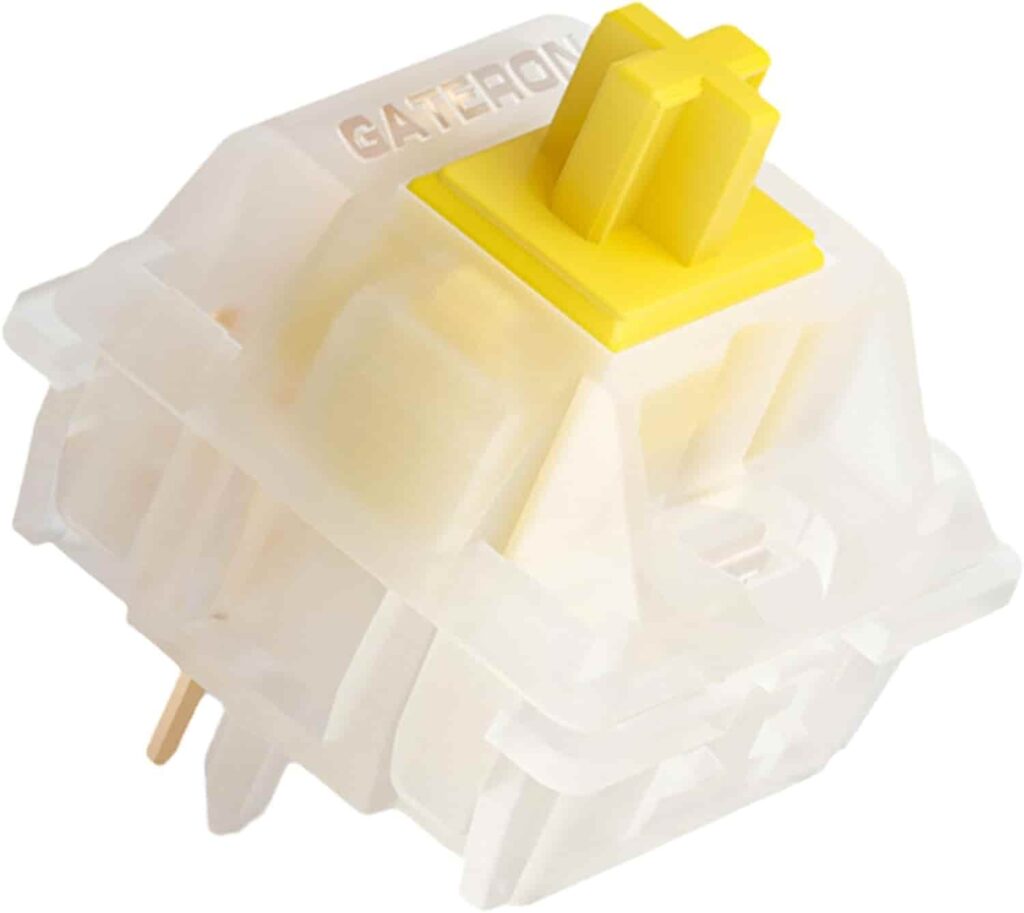
Gateron switches are often considered more affordable alternatives to Cherry MX switches. They offer a similar typing experience and come in various variants, including Gateron Red (linear), Gateron Blue (tactile and clicky), and Gateron Brown (tactile and silent).
3. Keycaps

Keycaps are the visible part of the keys and play a significant role in the aesthetics and feel of a keyboard. Keycaps can be made of materials such as PBT, known for its textured surface and resistance to wear, or ABS, which tends to be shiny but less durable. Double-shot keycaps have legends (letters or symbols) injected into the keycap during the manufacturing process, ensuring they won’t fade over time. Customization options include artisan keycaps with unique designs and profile options like SA, DSA, and Cherry.
Additional Features
- Function Keys (F1-F12): Perform specific tasks (e.g., adjusting brightness, volume, etc.).
- Media Keys: Control playback (play/pause, previous/next track).
- LED Indicator Lights: Show status (Caps Lock, Num Lock, Scroll Lock).
- Keyboard Feet: Provide an adjustable angle for comfortable typing.
- Volume Wheel/Knob: Adjust audio volume.
- USB Pass-Through Ports: Some keyboards have built-in USB ports for convenience.
Customization Options
Customizing your keyboard can enhance both functionality and aesthetics. Here are some popular customization options:
- Backlighting: Many keyboards feature options, including RGB effects and per-key lighting. Backlighting adds visual appeal and assists with visibility in low-light environments.
- Custom Keycap Sets: Replacing keycaps with custom sets is a popular way to personalize a keyboard. Unique designs and color schemes can transform the look and feel of your keyboard, making it stand out from the crowd.
- Performance: Swapping switches is an option for those seeking a different typing experience. Separate switches offer varying levels of tactile feedback, actuation force, and sound profiles. Lubbing switches with specialized lubricants can also enhance their smoothness.
Maintenance of Keyboard Parts
Regular maintenance is crucial to keep your mechanical keyboard in optimal condition. Here are some maintenance tips to ensure your keyboard stays clean and functional:
- Cleaning Tips:
Regularly cleaning your keyboard helps prevent dust buildup and maintains a hygienic workspace. You can use compressed air to remove dirt from the keys and keycaps. If you want to clean more thoroughly, you can use a keycap puller to remove individual keycaps. Just follow the manufacturer’s instructions to avoid damaging the keyboard.
- Replacement of Keys/Switches:
If you encounter any issues with specific keys or switches, such as keys not registering or feeling sticky. In that case, it may be necessary to replace them. Most mechanical keyboards allow for easy keycap and switch replacement, making it a straightforward process to troubleshoot and resolve any issues.
Conclusion
In conclusion, understanding the anatomy of a keyboard key is crucial for efficient typing, customization, and maintenance. We have explored the different types of keyboards, keycap sizes, keyboard components and their functions, maintenance tips, customization options, and standard keyboard layouts. By familiarizing yourself with these aspects, you can enhance your typing experience, troubleshoot issues, and personalize your keyboard to suit your preferences.
Do you have any favorite parts of a laptop keyboard or customization tips? Please share them with us in the comments below!
Happy typing!
What are the 5 parts of the keyboard?
- Alphanumeric keys: Letters, numbers, symbols for typing.
- Modifier keys: Shift, Ctrl, Alt, etc., change other keys’ functions.
- Navigation keys: Arrows, Home, End, PgUp/Dn, move the cursor.
- Function keys: F1-F12, perform special actions depending on the software.
- Numeric keypad (optional): Enter numbers quickly for calculations.
How do I choose a switch for my keyboard?
Selecting the perfect switch for your mechanical keyboard is similar to choosing the right ice cream flavor. Let’s explore the three main types of switches to help you find your ideal match.
1. Linear Switches (e.g., Cherry MX Red, Gateron Red):
- Feel: Linear switches provide a smooth keystroke without any tactile bump or audible click.
- Typing Experience: Ideal for gamers and those who prefer a consistent, quiet typing experience.
- Example: Cherry MX Red switches.
2. Tactile Switches (e.g., Cherry MX Brown, Kailh Brown):
- Feel: Tactile switches offer a gentle bump when you press the key.
- Typing Experience: Great for typists who appreciate feedback without the noise of clicky switches.
- Example: Cherry MX Brown switches.
3. Clicky Switches (e.g., Cherry MX Blue, Razer Green):
- Feel: Clicky switches combine a tactile bump with an audible click.
- Typing Experience: Perfect for those who want a satisfying, old-school feel and don’t mind the noise.
- Example: Cherry MX Blue switches.
Remember, there’s no one-size-fits-all answer. Trust your fingers, listen to your ears, and embark on your switch adventure! 🎹🔍🔢
Which type of switch should I choose for my mechanical keyboard?
Choose your switch!
- Smooth & Silent: Linear (MX Red) for fast, quiet typing.
- Bump for Feedback: Tactile (MX Brown) for accuracy without noise.
- Clicky & Satisfying: Clicky (MX Blue) for clear feedback and fun sounds.
What are the 5 functions of keyboard?
The main functions of the keyboard are:
- Typing: Entering text and symbols.
- Controlling software: Shortcuts and function keys trigger specific actions.
- Navigation: Moving the cursor around the screen.
- System commands: Accessing special options like Task Manager.
- Gaming: Specialized keyboards enhance gameplay with macro keys, etc.
What are the components of a mechanical keyboard?
Mechanical Keyboard components:
- Switches: Each key has a springy switch that registers your press.
- Keycaps: You press the plastic covers, and they are labeled with letters or symbols.
- PCB (Printed Circuit Board): Connects switches and sends signals to your computer.
- Plate: Holds the switches in place, often metal for sturdiness.
- Stabilizer bar: Balances longer keys like Enter and Spacebar.
What is inside of a keyboard?
Imagine a mini factory! Switches are pressed, signals travel through the PCB, and your computer interprets them as letters, commands, or game actions.
What is the structure of the keyboard?
Each keyboard has a unique layout, but the general structure involves organized zones for typing, function keys, navigation, and (sometimes) a number pad.
What is F1 f2 f3 f4 f5 f6 f7 f8 f9 f10 f11 F12?
F Keys (F1-F12): Function keys have varying purposes depending on your program. They can control media playback, access browser functions, refresh the screen, and more.
